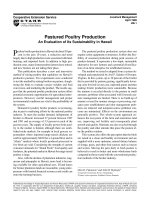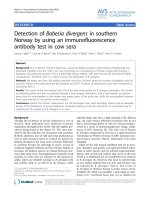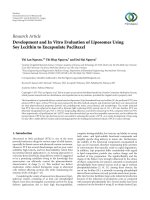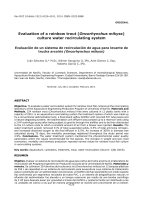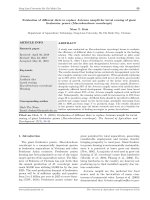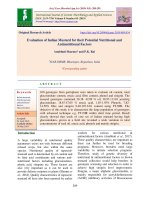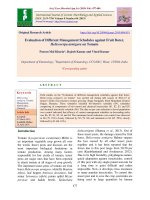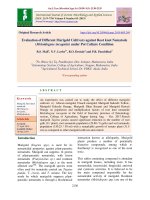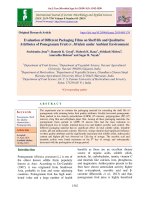Scientific evaluation of different brands of mustard oil available in markets of India using bellier turbidity temperature test (BTTT)
Bạn đang xem bản rút gọn của tài liệu. Xem và tải ngay bản đầy đủ của tài liệu tại đây (175.31 KB, 6 trang )
Int.J.Curr.Microbiol.App.Sci (2019) 8(9): 1736-1741
International Journal of Current Microbiology and Applied Sciences
ISSN: 2319-7706 Volume 8 Number 09 (2019)
Journal homepage:
Original Research Article
/>
Scientific Evaluation of Different Brands of Mustard Oil available in
markets of India using Bellier Turbidity Temperature Test (BTTT)
Shashikant Pardeshi*
D.P.H. L., Jalgaon, India
*Corresponding author
ABSTRACT
Keywords
Vegetable oil,
mustard seed oil,
BTTT.
Article Info
Accepted:
18 August 2019
Available Online:
10 September 2019
In this present work, the applicability of BTTT to mustard oils obtained
from different parts of India and thereby to examine and investigate the
influence of geographical variations on BTTT. In the present study,
different brands of mustard oils used for analysis, such as mustard oil (Mu,
Suraj), Kacchi ghani mustard oil (Kgmu, Mashal) Kacchi ghani mustard oil
(Kgmu1, Nature fresh), Kacchi ghani mustard oil (Kgmu2, Engine) and
Kacchi ghani mustard oil (Kgmu3, Saloni) exhibited BTT in the range of
26.8 to 27.5S0C. The result have demonstrated the reproducibility through
the analyzed data. Hence It is observed that mustard oil fulfils BTTT values
as per Regulation (Food Products and Standards) 2011 of Food Safety
Standards and Act 2006. The standard mean error is in between 0.06-0.15 in
case of BTT.
Introduction
Vegetable oils consists primary a large
molecules are called triglyceride of fatty acids.
Triglycerides are insoluble in water and greasy
to touch. They are extracted from seeds of
plants such as sunflower, soybean, mustard
and mustard oil. Vegetable oils are used for
various purposes like for cooking, for
industrial use, for pet food additive etc. In
India vegetable oil are widely used in frying,
backing and other types of cooking. It is also
used in food preparation and flavoring such as
salad dressing etc. So it is also term as edible
oil. Cooking oil like sunflower, soybean oil,
mustard oil, mustard oil containing
polyunsaturated and monounsaturated fatty
acids like linoleic acid, linolenic acid and oleic
acid, although some oils that contains
saturated fat, such as coconut oil, palm oil are
solid.
Lipid comprise a group of naturally occurring
molecules that includes fats, waxes, sterols, fat
soluble vitamins such as vitamin A,D,E and K,
monoglycerides, diglycerides, triglycerides,
phospholipids and others. Lipid may define as
hydrophobic small molecules. Lipids also
1736
Int.J.Curr.Microbiol.App.Sci (2019) 8(9): 1736-1741
encompass molecules such as fatty acids and
their derivatives including mono-, di- and
triglycerides[1].
Mustard oil extracted from seasonal crops
Brassica nigera, B.Junea and B. hitra has
enormous edible and non-edible uses in India.
The oil is consumed after extraction from
mustard seeds, generally without any further
processing, high price and dark colour of oil
make it vulnerable for adulteration. The
quality characteristics of fats and oils is
dictated by some distinct physical and
chemical parameters like texture, density
refractive index, specific gravity, iodine value,
colour, essential content, unsaponifable
composition, acid value, Free fatty acid
content, peroxide value,P-anisidine value and
BTT etc are dependent on the source of oil;
geographic, climatic, and agronomic variables
of growth of the oil helps to determine its
conformity as safe and standard edible oil by
which the purity check of mustard oil can be
done.
Thus one must assess quantitatively the
influence of these variables on characteristics
of oils and fats; in present case on
characteristics of mustard oil, Bellier
Turbidity Temperature Test (BTTT) (acetic
acid method), based on insolubility of
Arachidic acid is used as a qualitative method
for identification of pure mustard oil.
Sometimes it is observed that mustard oil
fulfils all specifications of refined oil but fails
to pass BTTT. is used as a qualitative method
for
identification
of
pure
mustard
oil.Moreover
mustard
from
different
geographical locations differs in oil content.
The objective of the present studies was to
investigate scientific evaluation and the
applicability of BTTT to the different brands
of mustard oils obtained from different parts
of India and thereby examine the influence of
geographical variations on BTTT as tool for
identification of mustard oil.
Brassica juncea L seed has potential for use
alternative source of industrial oil for
shampoo, soap making and pharmaceutical
creams, capsules, emulsions, fragrances,
flavours, intramuscular injections, nasal
sprays, ointments, plasters, and in a number of
cosmetics. In addition they are also used in
large quantities as raw material for bioresources.
The fatty acid profile of Brassica juncea L
seed oils were determined while oleic and
linoleic are most prominent fatty acids in these
oils, they also contain significant amounts of
saturated fatty acids [2]. Rapeseed-mustard
(Brassica species) is the major rabbi oilseed
crop of India. Mustard seed is the second most
important oil seed crop in India after soyabean
accounting for nearly 20-22% of the total
oilseeds produced in the country.
India is the fourth producer of mustard seed
contributing to around 11 % of world’s total
production. Rajasthan is the most giant
mustard growing state and alone contributes
43% of the total mustard seed production in
India.
The industry requires modern technology and
also appropriate technology to reduce the
content of erucic acid and pungency to make
the oil more acceptable among consumers and
tap export potential. For the record, production
of mustard/rapeseed, a winter crop cultivated
in the northern States was 8.028 million tones
last year with the crop sown on 6.362 million
hectares. Rajasthan is the major producer
contributing up to 47 per cent of the domestic
production, followed by Madhya Pradesh
(11.44 per cent), Haryana (12 per cent) and
Uttar Pradesh (10.41 per cent)[4].
The Bellier figure or the temperature at which
turbidity appears in a specified and neutralised
oil sample under specified conditions was first
proposed by Bellier and modified by several
1737
Int.J.Curr.Microbiol.App.Sci (2019) 8(9): 1736-1741
workers including Franz and Adler. According
to Ever in 1912, the addition of sufficient
acetic acid used instated of 1% hydrochloric
acid succeeding modifications in the BTT.
This had been adopted by several workers and
gives satisfactory results for sufficient to judge
the purity of mustard oil and admixture of oils.
In most cases the Bellier figure increases with
the % of mustard oil in the mixture. The
increase is not proportional and there is a steep
rise for the % of mustard oil below 25 %.The
solubility of oils in various solvents is a
constant, depending on the nature of the
glycerides composing the oil. Fryer and
Weston found that a mixture of equal volume
of 92% ethyl alcohol and pure amyl alcohol
used as a solvent for turbidity.
In Valenta test, acetic acid was used as a
solvent, the results are affected by the
presence of moisture in the oil and free fatty
acid which lower the turbidity temperature,
increasing the solubility of the oils, which
raises the turbidity temperature [3].
The modified BTT test has been used by Ever
for judging the purity of oils and has been
found simple, rapid and fairly accurate for
routine analysis as compared to the results
obtained by Valenta test. Moreover, it can be
conveniently used in the analysis of soap and
commercial fatty acids and also for
determining the % of two mixed oils. Others
workers have also successfully used the same
test for determining adulteration of mustard oil
in some edible oils and also suggested its
analytical importance. Besides the turbidity
temperatures obtained with fatty acids by the
method of fryer and Weston are different from
those for the respective oils, depending on the
difference in the solubility of the glycerides of
the oil and its fatty acids in the same solvent
[5]. The following table shows that the
imposition of BTT values to raise the issue
pertaining to the discrepancy in BTT for the
presence of other vegetable oils (Admixtures
of oils) in mustard oil[9].
All the above Mustard oil sample did not
conform to the standards laid down for the
mustard oil under Prevention of food
Adulteration Act 1954 and rules and Food
safety standards Act2006 and rules and
regulations, thereof, in that BTT values falls
above the maximum requirement of 27.50C.
Materials and Methods
All the chemicals and reagents were analytical
grade and used as received. Five mustard oils
of different brands such as mustard oil (Mu,
Suraj), Kacchi ghani mustard oil (Kgmu,
Mashal) Kacchi ghani mustard oil (Kgmu1,
Nature fresh), Kacchi ghani mustard oil
(Kgmu2, Engine) and Kacchi ghani mustard
oil (Kgmu3, Saloni) were gathered from super
market of different places of India. all these
brands were in different forms of packaging
while some were in poly packs,jar, tin and
tetra pack. Since these five mustard oils were
easily available for procurement. These
different mustard oils are used in the
investigations on BTTT in this research study.
Determination
of
Bellier
temperature acetic acid Method
turbidity
Pipette out one ml of the filtered sample of oil
in a flat-bottom 100 ml round flask, add 5ml
of 1.5 N alcoholic potash heating over a
boiling water bath using an air condenser
After complete saponification cooling,
neutralised by adding carefully dilute acetic
acid and then add an extra amount of 0.4 ml of
accurately measured dilute acetic acid using
phenolphthalein indicator. Add 50 ml of 70%
alcohol and mixed well. Heat and allow the
flask to cool in air with frequent shaking. Note
the temperature by using calibrated
thermometer at which the first distinct
turbidity appears which is the turbidity
temperature.
1738
Int.J.Curr.Microbiol.App.Sci (2019) 8(9): 1736-1741
This turbidity temperature is confirmed by a
little further cooling which results in
deposition of the precipitate. Dissolve the
precipitate by heating the contents to 50°C
over water bath, again cool as desiccated
above and make a triplicate determination of
the turbidity temperature [6,8].
Statistical analysis
The data obtained from the experimental
measurements and accuracy of BTTT for
different brands of mustard oils have been
analyzed and the Statistical parameter like
standard deviation, coefficient of variance and
standard mean error were calculated for both
the parameters. All the experiment was carried
out in triplicate and the results are presented as
the mean SD, CV and SEM. Descriptive
Statistics of different mustard varieties from
different parts of India as shown in figure1
and 2.
Results and Discussion
mustard oils obtained from different places of
India are shown in Table3.The prescription of
the BTT test created some example of
prosecution under prevention of food
adulteration act 1954 and food safety act, rules
and regulations 2011 and shows that the
imposition of BTT values to raise the issue
pertaining to the discrepancy in BTT for the
presence of other vegetable oils (Admixtures
of oils) in mustard oil [9]. The results obtained
for BTTT for the mustard oils from five
different brands of mustard oil from different
places of India are shown in Table3.The data
obtained from Mu (26.8), Kgmu(27.5),
Kgmu1(27.4), Kgmu2(27.1) and Kgmu3(26.9)
displayed BTT in the range of 26.8 to 27.5°C.
As all the reported BTTT values are average
of three readings, the results have
demonstrated the reproducibility of the
analysis data. Thus the present investigations
prove with due certainty the applicability of
BTTT to all five mustard oil. Table 3 shows
the accuracy, the standard deviation and
coefficient is in between 0.1-0.26 and 0.360.98.
The results obtained for BTTT from the
Table.1 Shows BTT standards/values for some edible vegetable oils under 2.2: Fats, oils and Fat
emulsions as per FSSA 2006[7]
Sr.no
1
2
3
4
5
6
7
8
9
Item no
2.2.1.2
2.2.1.3
2.2.1.6
2.2.1.7
Vegetable oil
BTT limits
Cotton seed oil
19.0 -21.00C
Groundnut oil
39.0-41.00C
Rape seed oil Mustard oil (toria oil)
23.0-27.5 0C
Rape seed oil or Mustard oil-Low erucic Not
more
than
acid
19.00C
2.2.1.8
Virgin olive oil
17.00C Max
Refined olive oil
17.00C Max
2.2.1.10 Safflower seed oil (barrey ka tel)
Not more than 16.00C
2.2.1.12 Til oil (Gingelly/sesame oil)
Not more than 22.00C
2.2.1.13 Niger seed oil (sargiya ka tel)
25.0-29.00C
2.2.1.17 Almond oil
Not more than 60.00C
Source FSSA2006
1739
Int.J.Curr.Microbiol.App.Sci (2019) 8(9): 1736-1741
Sr. Name of Oil
No
Mustard oil
1
2
Mustard oil
3
Mustard oil
4
Mustard oil
5
Mustard oil
Prosecution name
Year Under PFA/FSSA BTT
Parameter to fail
Jagdish Prasad Alias 1971 BTT and others
Exceed the
jagdish verses State of
maximum
West bengal
requirement
Sohan singh alias swaran 2000 BTT and others
Exceed the
singh verses State of U.P.
maximum
requirement
Sheo charan S/o Ram 2000 BTT and others
Exceed the
Chandra sahai verses
maximum
State U.P.
requirement
Laldas sahu verses State 1986 BTT and others
Exceed the
of U.P.
maximum
requirement
Netai Chandra and others 1965 BTT and others
Exceed the
verses corporation of
maximum
culcutta
requirement
Table.2 BTTT of different mustard oils with accuracy on BTT
Sr.No
Name of oil
Brand name
Code
BTTT*
SD
CV%
SEM
1
Mustard oil
Suraj
Mu
26.8
0.2
0.75
0.12
2
Kacchi ghani mustard oil
Mashal
Kgmu
27.5
0.1
0.36
0.06
3
Kacchi ghani mustard oil
Nature fresh
Kgmu1
27.4
0.17
0.63
0.09
4
Kacchi ghani mustard oil
Engine
Kgmu2
27.1
0.26
0.98
0.15
5
Kacchi ghani mustard oil
Saloni
Kgmu3
26.9
0.26
0.97
0.15
*Each value is averages of three measurements, SD-standard deviation, CV-coefficient of variance, SEMstandard mean error
Fig.1 shows the BTTT values for different Mustard oil
1740
Int.J.Curr.Microbiol.App.Sci (2019) 8(9): 1736-1741
Fig.2 shows statistical values for different Mustard oil
Recommendation
BTT is qualitative cheaper method hence the
quantitative method should be essential for
prescribed data and supplemented with GC
and HPLC analysis, which provide the
quantitative data on presence of high
molecular weight fatty acids in mustard oils.
The present investigations prove with due
certainty about applicability of BTTT to all
five mustard oil varieties. This study also
confirms prove reliability, reproducibility and
diverse applicability of BTTT.
References
Shinde et al.,(2017),Pranjali Shinde and Shelly
Gupta, Thermal degradation of fatty
acids during repeatedly frying of
vegetable oil: A survey review, Indian
journal of research,6(5),278-81.
Purendra Singh (2018), Physico-chemical
investigations of Mustard seed (Brassica
juncea L) International Journal of
Scientific Research in Multidisciplinary
Studies,4(6),
24-27.
Norman (1936), Norman Evers., The detection of
archis oil in olive and almond oil,
Analyst 62:96.
Retail research mustard crop survey report 201314-15
Desai (1947), Desai C.M., Turbidity Temperature
of oils as determines by Belier’s Test
and Its significance as an Analytical
constant,
current
science,16(3),9294.
DGHS, (2012)., Directorate General of Health
Services, Manual of methods of analysis
of foods (Oils and Fats) Food Safety and
Standards Authority of India (FSSAI),
Ministry of health and family Welfare,
Government of India, New Delhi.
FSSA 2006 (2014).,Food safety and standards Act
2006, Rules 2008, Regulations 2011, 8th
edition, Professional book publishers, New
Delhi, India..
I.S.I.(1984).,Indian Institution of standards,
Bellier Turbidity Test, Handbook of food
analysis and (part XIII)90.
www. turbidity test of mustard oils through
www.google.com
How to cite this article:
Shashikant Pardeshi. 2019. Scientific Evaluation of Different Brands of Mustard Oil available
in markets of India using Bellier Turbidity Temperature Test (BTTT).
Int.J.Curr.Microbiol.App.Sci. 8(09): 1736-1741. doi: />
1741

